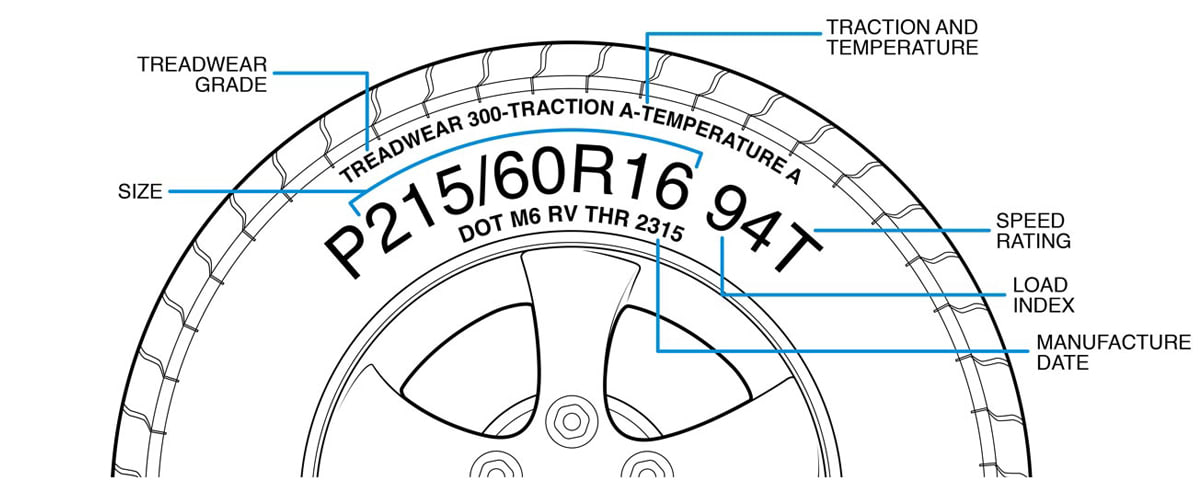Tire Guide
Guide to the Correct Size
Find your tire size using the tire library guide tools, Sizemytires could be a handy tool to identify the sizes of tires for your vehicles *
*We are NOT responsible for fitment errors. The most important aspect of purchasing a tire is its size, which cannot vary. It is buyer's responsibility to verify the tire size information. It is buyer's responsibility to verify whether a specific tire is suitable for a specific vehicle. However, this tire size may be fitted on other vehicles as well. To ensure that you are purchasing the correct tire size for your vehicle, please check the size of your currently mounted tires (locate on the tire's sidewall). The tire's sidewall also features the speed and load rating, indicating the speed and load capacity of the specific tire. The speed and load index can differ from the tires you currently have mounted on your vehicle up to a degree. Please check your vehicle's Owner's Manual or consult with your mechanic regarding the changes of your tire's speed rating and load index. If you have any questions regarding your tire size , speed rating and load index please contact us prior to purchasing and confirm with certified auto technician of any variance in speed and load index and sizes.
Choosing the Best Tire
Tire Types
When it comes time to replace your tires, it pays to know what is currently on your vehicle and to learn about your options. In most cases, you’ll want similar replacements, matching the size and speed rating. From there, you can use the ratings to find models that excel in the areas that may matter most to you, such as braking, handling, ride comfort, and noise.
All-Season Car Tires
All-season tires come in sizes to fit everything from small cars to light-duty SUVs and pickups. They are for drivers who want year-round traction, long treadwear, and a comfortable ride. But all-season tires typically lack the precise handling and grip of performance tires.
Speed ratings: None, S (112 mph), T (118 mph)
Treadwear warranty: None or 40,000 to 100,000 miles
Typical wheel size: 14 to 18 inches
Performance All-Season Car Tires
Performance all-season tires provide year-round grip tuned for enthusiastic driving. They have a higher speed rating than standard all-season tires, and they generally provide better handling and braking than regular all-seasons.
Speed ratings: H (130 mph), V (149 mph)
Treadwear warranty: None or 40,000 to 80,000 miles
Typical wheel size: 15 to 20 inches
Ultra-High-Performance Tires
All-season and summer ultra-high-performance tires are commonly fitted to upscale sedans or sporty vehicles. All-season UHP tires are designed to provide good handling and responsive steering in wet and dry conditions, but the treadwear and ride comfort are common compromises. Summer UHP tires are not intended for cold weather and won’t grip in snowy or icy conditions. All-season versions may compromise some dry and wet grip to gain winter traction.
Speed ratings: ZR (149-plus mph), W (168 mph), Y (186 mph)
Treadwear warranty: None or 30,000 to 60,000 miles
Typical wheel size: 17 to 22 inches
All-Season Truck Tires
All-season truck tires are designed for the heavy loads an SUV or pickup can move. These are well-rounded tires designed to perform well in most conditions.
Speed ratings: S (112 mph), T (118 mph), H (130 mph)
Treadwear warranty: None or 40,000 to 80,000 miles
Typical wheel size: 15 to 22 inches
All-Season SUV Tires
All-season SUV tires are specifically designed for modern SUVs, splitting the difference between car and truck tires. They are tuned for the performance, light-duty towing, and off-roading capabilities of those vehicles.
Speed ratings: T (118 mph), H (130 mph)
Treadwear warranty: 60,000 to 90,000 miles
Typical wheel size: 16 to 20 inches
All-Terrain Truck Tires
Engineered for more heavy-duty applications, all-terrain truck tires are suitable for use on paved roads and light off-road use. The more rugged tread is designed to provide added traction on unpaved and snowy roads.
Speed ratings: S (112 mph) for many
Treadwear warranty: None or 50,000 to 60,000 miles
Typical wheel size: 15 to 20 inches
How to Read a Tire Sidewall
Tires have a wealth of information encoded on their sidewalls. When replacing them, we recommend staying with the size and speed rating of your car’s original tires. Check your owner’s manual for more information.
Size: On the tire below, 215 is the cross-section width in millimeters; 60 is the ratio of sidewall height to its width (60 percent); R indicates radial-ply construction; and 16 is the wheel rim’s diameter in inches.
Load index: Shorthand for the weight each tire can carry safely. The 94 here means 1,477 pounds per tire—pretty typical for a midsized car tire. That’s the maximum tire load.
Speed rating: A letter denoting the tire’s maximum speed when carrying the load defined by the load index—and not how fast you should drive! Standard all-seasons are usually rated S (112 mph) or T (118 mph). Climbing up the scale are H (130 mph), V (149 mph), ZR (149-plus mph), W (168 mph), and Y (186 mph) ratings. Winter tires may carry the letter Q (99 mph) or higher.
Treadwear grade: A government-required number that indicates a tire’s expected wear. A grade of 300 denotes a tire that will wear three times as well as a tire graded 100. But the numbers are assigned by tire manufacturers, not an independent third party.
Traction and temperature scores: Those scores denote a tire’s wet-stopping ability and temperature resistance. For traction, AA is best, C is worst. For temperature resistance, scores range from A (best) to C.
Manufacture date code: Every tire has a Department of Transportation number after the letters on the sidewall. The last four digits show the week and year the tire was made; for example, the digits 2315 would signify that the tire was made during the 23rd week of 2015. Don’t buy tires more than a couple of years old.

